Family name: Cyclanthaceae Poiter ex A. Richard
Synonym(s): [none]
Common name(s): panama-hat family
*Number of genera/species: 12/230
List of genera records in GRIN-Global
fruit
Fruit usually indehiscentindehiscent:
not opening on its own, as in a fruit
 , berryberry:
, berryberry:
an indehiscent, fleshy fruit with one or a few to many seeds. The flesh may be homogenous throughout. Or, if the outer part is hard, firm, or leathery, referred to as an hesperidium. Septa are present in some, and the seeds may be arillate or with a fleshy testa. (simple or multiplemultiple:
(simple or multiplemultiple:
fruit formed from several flowers clustered in one mass
), angledangled:
2D shape—having sides that meet at acute or obtuse angles
or squaresquare:
2D shape—geometric figure bounded by 4 straight sides of equal length and 4 90º-angles
, angledangled:
2D shape—having sides that meet at acute or obtuse angles
in transectiontransection:
a cross section; representing a plane made by cutting across an organ at a right angle to its length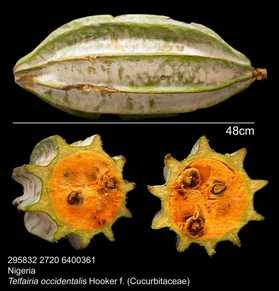 , with persistent stylar remnantsstylar remnants:
, with persistent stylar remnantsstylar remnants:
remnant of a style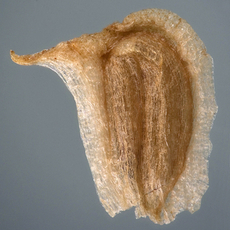 , few to many seeded, pedunclepeduncle:
, few to many seeded, pedunclepeduncle:
stalk of an inflorescence
and/or bracts often persistent. Pericarppericarp:
fruit wall or fruit coat
orange or red, fleshyfleshy:
texture—fairly firm and dense, juicy or at least moist, and easily cut
, apexapex:
the point farthest from the point of attachment, or the "tip" of an organ
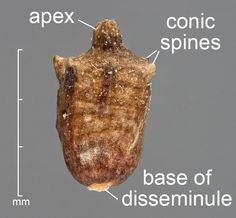 sometimes lignified. BerriesBerries:
sometimes lignified. BerriesBerries:
an indehiscent, fleshy fruit with one or a few to many seeds. The flesh may be homogenous throughout. Or, if the outer part is hard, firm, or leathery, referred to as an hesperidium. Septa are present in some, and the seeds may be arillate or with a fleshy testa. are simplesimple:
are simplesimple:
fruit formed from a single flower with one pistil, solitary carpel or several fused carpels
or free (Evodianthus, Dianthoveus, Schultesiophytum, Chorigyne) or basally to fully connate forming a syncarpsyncarp:
fruit derived from fusion of numerous ovaries in a many-flowered inflorescence or a flower with numerous carpels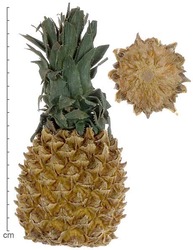 . BerriesBerries:
. BerriesBerries:
an indehiscent, fleshy fruit with one or a few to many seeds. The flesh may be homogenous throughout. Or, if the outer part is hard, firm, or leathery, referred to as an hesperidium. Septa are present in some, and the seeds may be arillate or with a fleshy testa. have circumscissilecircumscissile:
have circumscissilecircumscissile:
(~pyxis); type of capsular dehiscence, opens by a lid (splitting transversely)
 dehiscence in Asplundia, Thoracarpus, and Sphaeradenia and explosive in Dicranopygium. In Cyclanthus, fruits are united forming drydry:
dehiscence in Asplundia, Thoracarpus, and Sphaeradenia and explosive in Dicranopygium. In Cyclanthus, fruits are united forming drydry:
texture—free or relatively free from water or liquid
, hollow ringed (or spiraled) syncarps, which open up transversely revealing the seeds inside.
Seed shape is highly variable from globoseglobose:
3D shape—more or less spherical
 to C-shapedC-shaped:
to C-shapedC-shaped:
2D-shape—semiannulate, curved into the shape of the letter 'C'
, rapheraphe:
a ridge or seam on the seed coat, formed by the portion of the funiculus united to the ovule wall in longitudinally curved ovules
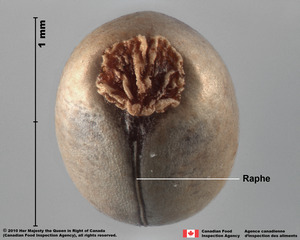 conspicuous, flattened or tereteterete:
conspicuous, flattened or tereteterete:
approximately circular in cross section; width and thickness approximately equal
 in transectiontransection:
in transectiontransection:
a cross section; representing a plane made by cutting across an organ at a right angle to its length , 1.4–5 mm long. Stelestylis seeds winged or long-caudate and fusiformfusiform:
, 1.4–5 mm long. Stelestylis seeds winged or long-caudate and fusiformfusiform:
spindle-shaped; broadest at the middle and tapering at both ends
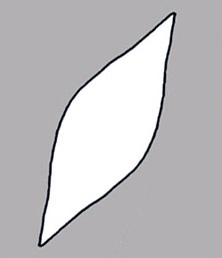 . Seed coat brown, thinthin:
. Seed coat brown, thinthin:
having or being of relatively little depth
, leatheryleathery:
texture—moderately thick, tough, and very pliable
or firmfirm:
texture—yielding under only moderately strong pressure; only slightly deformable without internal structural disruption
, smooth, striatestriate:
surface relief—having fine, parallel lines, grooves or ridges to wartywarty:
to wartywarty:
surface relief—distinct, rounded projections that are large relative to the fruit size; tuberculate, verrucose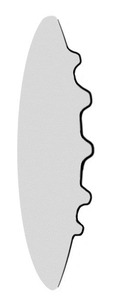 . Ludovia integrifolia seeds have carunclescaruncles:
. Ludovia integrifolia seeds have carunclescaruncles:
a localized outgrowth of the seed coat near the hilum of the seed; it functions as an elaiosome
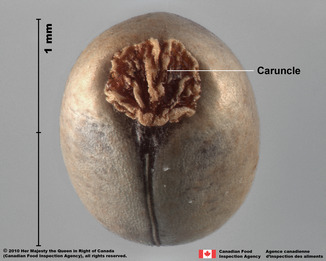 .
.
Embryo well developed, linearlinear:
(shape) long, narrow, and uniform in width; (of embryo) embryo is straight and much longer than wide
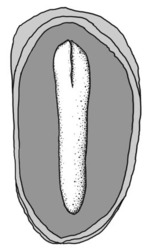 , bentbent:
, bentbent:
(of embryo) embryo is bent at an acute, V-shaped angle with the ends close together and generally thick cotyledons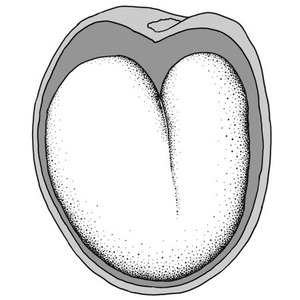 or straight, basalbasal:
or straight, basalbasal:
at or pertaining to the point of attachment; (of embryo) embryo occupies one end of the seed
, partially fills seed coat. Endospermendosperm:
nutritive starch- and oil-containing tissue present in many seeds
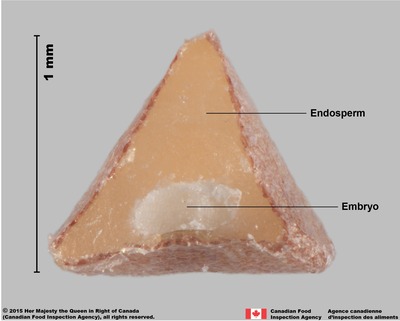 copious, hard or soft, smooth, often ruminateruminate:
copious, hard or soft, smooth, often ruminateruminate:
testa or seed coat folded into the endosperm .
.
| Fruit | |
| Type | berryberry: an indehiscent, fleshy fruit with one or a few to many seeds. The flesh may be homogenous throughout. Or, if the outer part is hard, firm, or leathery, referred to as an hesperidium. Septa are present in some, and the seeds may be arillate or with a fleshy testa.  |
| Shape(s) | angular, square |
| Texture | fleshyfleshy: texture—fairly firm and dense, juicy or at least moist, and easily cut |
| Color(s) | orange, red |
| Unique features | Orange or red, fleshyfleshy: texture—fairly firm and dense, juicy or at least moist, and easily cut , angledangled: 2D shape—having sides that meet at acute or obtuse angles or squaresquare: 2D shape—geometric figure bounded by 4 straight sides of equal length and 4 90º-angles berriesberries: an indehiscent, fleshy fruit with one or a few to many seeds. The flesh may be homogenous throughout. Or, if the outer part is hard, firm, or leathery, referred to as an hesperidium. Septa are present in some, and the seeds may be arillate or with a fleshy testa.  . Or, bright colored ringed or spiral shaped fruits on a stalk. . Or, bright colored ringed or spiral shaped fruits on a stalk. |
| Seed | |
| Size range | 1.4–5 mm long |
| Shape(s) | oblong, globoseglobose: 3D shape—more or less spherical  , curvedcurved: , curvedcurved:(of embryo) linear embryo is curved into an arch or horseshoe with the ends far apart 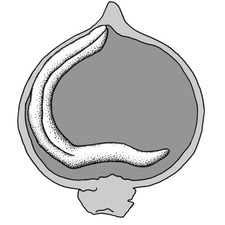 , fusiformfusiform: , fusiformfusiform:spindle-shaped; broadest at the middle and tapering at both ends  , irregular, ellipsoidellipsoid: , irregular, ellipsoidellipsoid:3D shape—elliptic , ovoidovoid: 3D shape—ovate  , rectangular, C-shaped , rectangular, C-shaped |
| Surface relief | reticulate, ridgedridged: surface relief—raised, thick ridges, sharp edged or rounded, usually in a series that may cover the entire surface 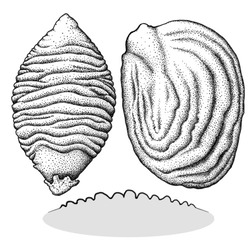 , striatestriate: , striatestriate:surface relief—having fine, parallel lines, grooves or ridges  , granulargranular: , granulargranular:surface relief—having a grainy surface 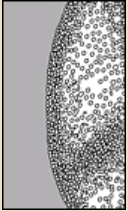 , warty , warty |
| Color(s) | brown |
| Unique features | Seeds with conspicuous rapheraphe: a ridge or seam on the seed coat, formed by the portion of the funiculus united to the ovule wall in longitudinally curved ovules  and ruminateruminate: and ruminateruminate:testa or seed coat folded into the endosperm  endospermendosperm: endospermendosperm:nutritive starch- and oil-containing tissue present in many seeds  . . |
| Other | |
| Embryo | well developed, linearlinear: (shape) long, narrow, and uniform in width; (of embryo) embryo is straight and much longer than wide  , bentbent: , bentbent:(of embryo) embryo is bent at an acute, V-shaped angle with the ends close together and generally thick cotyledons  or straight, basalbasal: or straight, basalbasal:at or pertaining to the point of attachment; (of embryo) embryo occupies one end of the seed , partially fills seed coat |
| Nutritive tissuenutritive tissue: tissue within the seeds that nourishes the developing embryo; such as endosperm, perisperm, or chalazosperm in angiosperms; megagametophyte in gymnosperms |
endosperm endosperm: nutritive starch- and oil-containing tissue present in many seeds  copious, hard or soft, smooth, often ruminate copious, hard or soft, smooth, often ruminate |
Tropical America including the West Indies.
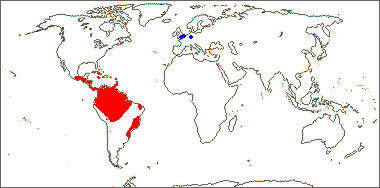
Distribution map courtesy of Angiosperm Phylogeny Website.
Baskin and Baskin 2021Baskin and Baskin 2021:
Baskin C and Baskin J. 2021. Relationship of the lateral embryo (in grasses) to other monocot embryos: A status up-grade. Seed Science Research 31 (3): 199-210. doi:10.1017/S0960258521000209; Dahlgren et al. 1985Dahlgren et al. 1985:
Dahlgren RMT, Clifford HT, and Yeo PF. 1985. The families of the monocotyledons: structure, evolution, and taxonomy. Springer-Verlag, Berlin. 520 pp.; Eriksson 2009Eriksson 2009:
Eriksson R. 2009. Neotropical Cyclanthaceae. In: Milliken W, Klitgard B, and Baracat A, eds. Neotropikey - Interactive key and information resources for flowering plants of the Neotropics. Accessed 04 May 2021. URL: https://powo.science.kew.org/taxon/urn:lsid:ipni.org:names:77126752-1/general-information#source-NTK; Kirkbride et al. 2006Kirkbride et al. 2006:
Kirkbride JH, Jr, Gunn CR, and Dallwitz MJ. 2006. Family guide for fruits and seeds, vers. 1.0. Accessed September 2020ndash;January 2022. URL: https://nt.ars-grin.gov/seedsfruits/keys/frsdfam/index.cfm .; Kubitzki et al. 1990+Kubitzki et al. 1990+:
Kubitzki K et al., eds. 1990+. The families and genera of vascular plants. 7+ vols. Berlin etc.; Stevenson and Loconte 1995Stevenson and Loconte 1995:
Stevenson DW and Loconte H. 1995. A cladistic analysis of monocot families. In: Rudall PJ, Cribb PJ, Cutler DF, and Humphries CJ, eds. Monocotyledons: Systematics and Evolution. Royal Botanic Gardens, Kew.; Takhtajan 2009Takhtajan 2009:
Takhtajan A. 2009. Flowering plants: Second edition. Springer Nature, Switzerland. 871 pp.
*The number of genera and species is based on Christenhusz and Byng 2016Christenhusz and Byng 2016:
Christenhusz MJM and Byng JW. 2016. The number of known plant species in the world and its annual increase. Phytotaxa 261 (3): 201ndash;217. https://doi.org/10.11646/phytotaxa.261.3.1, which may differ from the number of genera in GRIN-Global.